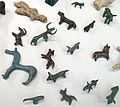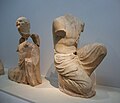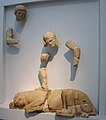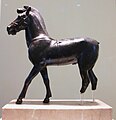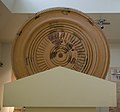Archaeological Museum of Olympia
Archaeological Museum of Olympia
Building
[edit]Bronze Age
[edit]-
Cycladic type figurines, 2800-2200 BC
-
Early Helladic pottery, EH II, 2650-2150 BC
-
Mycenaean (Late Helladic) pottery, 1500-1100 BC
Greek Geometric style
[edit]General views of small votive pieces
[edit]-
900-700 BC
-
900-700 BC
Terracotta figurines in Geometric style
[edit]1000-680 BC (maybe inclusive of submycenaean)
Bronze figurines in Geometric style
[edit]-
8th - (early) 7th century BC
-
Dancing Nymphs, 8th century BC
-
Charioteer
-
750-725 BC
-
8th century BC
-
early 7th century BC
Other small bronzes in Geometric style
[edit]-
Cauldron, 800 BC
-
Cauldron, 8th century BC
-
Heracles struggling with Apollo, 8th century BC
Greek Archaic period
[edit]Archaic Statues
[edit]-
Goddess, 7th c. BC
-
Hera from Heraion, 600 BC
Archaic small bronzes
[edit]Imported Asyrian and Neo-hittite bronzes
[edit]-
Neo-hittite bronze), 8th-7th c. BC
-
Assyrian bronze, 8th c. BC
-
Assyrian bronze, 7th c. BC
-
Assyrian bronze, 7th c. BC
-
Assyrian bronze, 7th c. BC
-
Assyrian bronze, 7th c. BC
Greek archaic small bronzes
[edit]-
Gryfons, protomai, late 7th c. BC
-
Gryfon shield laminate, 630-620 BC
-
Centaurs and Kaineus
-
Siren or Erinys, 590-580 BC, inv. B 6500
-
Gorgo shield laminate, 600-550 BC, inv. B 4990
-
Gorgo shield laminate, 600-550 BC
-
Silenus, 6th c. BC, inv. B 5555
-
Shield laminate, 6th c. BC
-
Jumping weights, 550-525 BC
-
Corinthian bronze helmets.jpg
-
Helmet of Miltiades that he used in the battle of Marathon, and Assyrian helmet as trophy of the Persian wars
-
Helmet of Miltiades, early 5th c. BC
-
Horn and ear of a bull, early 5th c. BC
-
Ornamental cauldron handle, Attic work, 480 BC
Greek archaic pottery
[edit]-
Elean and Corinthian pottery, 7th-6th BC
-
Elean and Corinthian pottery, 6th-5th BC
Treasury of Megara
[edit]520 BC
Greek Classical period
[edit]Greek Classical sculptures
[edit]Fragments of the Temple of Zeus
[edit]East Pediment
[edit]A solemn moment before the chariot race between Pelops and Oinomaos waged for the hand of Oinomaos' daughter, Hippodameia (and the inheritance of Oinomaos' kingdom). The moment when each side stands in array is believed to represent the taking of the oath to Zeus, god of righteousness, which neither man has any intention of honoring.
West Pediment
[edit]Victory of the Lapith people against marauding centaurs. Apollo at the center stretches out the hand of fiat, believed symbolic of the triumph of order over disorder.
-
Apollo
Metopes
[edit]Panels below the pediments, six on an end, each containing a relief sculpture representing a labor of Hercules.
-
Augean stables
-
Nemean lion
-
Apples of the Hesperides
-
Apples
-
Cretan bull
-
Cretan bull
-
Stymphalian birds
Zeus abducts Ganymede
[edit]Late archaic larger terracotta, 110 cm, 480-470 BC, T2
Nike of Paionios
[edit]421 BC (Roman copy of the head is in the Ancient Agora Museum in Athens)
Hermes bearing the child Dionysos
[edit]Praxiteles, 330 BC
Other Greek Classical artifacts
[edit]-
470 BC, bronze horse
-
same horse
-
1st half of 5th BC, bronze head of battering ram
-
Dolphin, 400 BC
-
Larger terracotta, ca 450 BC
-
Afrodite, Praxiteles type, 4th c. BC
-
Disk-shaped akroteria of terra cotta fitted over the gables of the temple of Hera, one on each side. 590 BC - early 4th BC.
From the workshop of Feidias in Olympia
[edit]From the workshop of Feidias in Olympia, ca 430 BC
-
Feidias cup
-
Clay molds from the workshop of Phidias
-
Antefix
-
Model of the workshop of Phidias
Vases
[edit]-
Glass oinochoe, 5th c. BC
-
Red-figure vase, 4th c. BC
Hellenistic period
[edit]-
Pan, terracotta, late 3rd century BC
-
Marble lions-head water spout, 2nd c. BC
-
Damaged bronze head
-
Restored modern copy
-
Domestic pottery of the Late Classical and Hellenistic periods
-
Hellenistic black pottery
Roman Age
[edit]-
Floor mosaic, theme of athletes
Roman Age Sculptures
[edit]-
Lion's-head water spout
-
Agrippina minor
-
Poppaea Sabina
-
Antinous as a shepherd, 117-130 AD
-
Lucius Verus?, 150-200 AD
-
Corinthian capital, 2nd c. AD
Sculptures from the Nymphaeum
[edit]Sculptures from the Nymphaeum of Herodes Atticus, mostly 149-153 AD
-
Appius Annius Gallius?
-
Atilia Caucidia Tertulla?
-
Faustina the Elder
-
Faustina the Younger
-
Hadrian
-
Marcus Aurelius, 150-200 AD
Roman Age Glassware
[edit]-
1st-4th c. AD
Unspecified pieces
[edit]-
Early geometric?


















